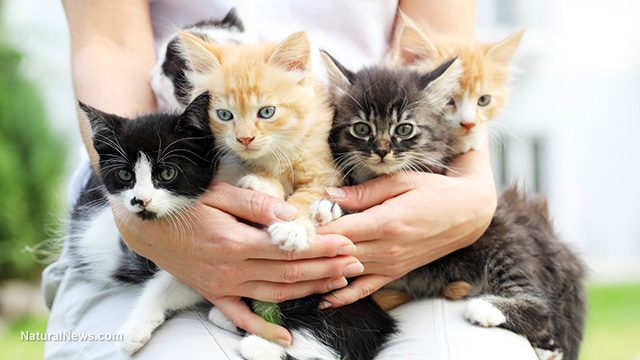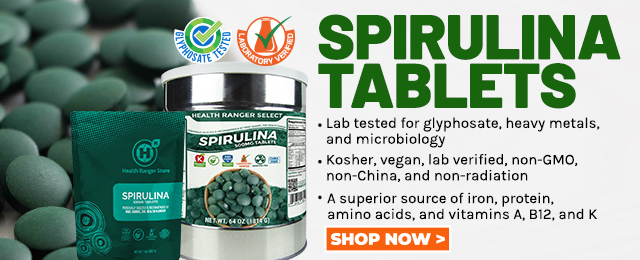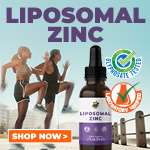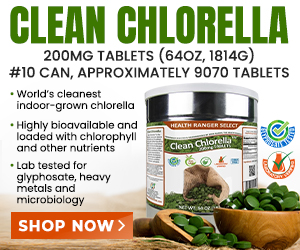Cat-scratch disease: Why cuddling a kitten could actually kill you
Friday, September 30, 2016 by: Isabelle Z.
Tags: kittens, cat-scratch disease, fleas

(NaturalNews) Pets can enhance people's lives in a number of very positive ways, such as by providing companionship, reducing stress and even improving their overall health. However, for a few unlucky people, cuddling their precious cat could lead to a life-threatening infection.
While most people have heard of "cat scratch fever," few people are aware that the condition, which is also referred to as cat-scratch disease, can actually be fatal if left unchecked. It is caused by bacteria and is passed between cats via fleas. Despite the name, getting scratched or bitten by an infected cat is not the only way to contract the illness; nuzzling or kissing your feline friend can be enough for it to take hold. It can also be spread when a cat licks a human's open wound.
The Centers for Disease Control and Prevention (CDC) reports that around 40 percent of cats will carry the bacteria that causes this disease at some point in their life. Carrying this illness will not make a cat sick, but it can cause a high fever, headache and exhaustion in people. Between three and 14 days after exposure the infected area could appear swollen, and raised lesions or pustules might appear.
Data from health insurance claims made during the period from 2005 to 2013 shows that around 12,000 people are diagnosed with the illness each year, with around 500 people being hospitalized with it annually.
According to a comprehensive survey by the CDC, kittens and stray cats are particularly vulnerable to the illness. The CDC also found that the scope of the illness to be greater than they initially believed. The study encompassed eight years and more than 13,000 cases of cat-scratch disease. The yearly incidence of 4.5 diagnoses per 100,000 population, despite being higher than they expected, is still somewhat rare overall. While just a few of these cases proved to be fatal, delays in seeking medical treatment were a big factor.
Tips for preventing cat-scratch disease
Thankfully, cat-scratch fever can be prevented with relative ease. Doctors recommend that cat owners wash their hands thoroughly with soap and water immediately after touching their pet and keep their cats away from strays. If you are scratched or bitten by a cat be sure to clean the area immediately. Do not allow cats to lick you on any part of your body that has an open wound, and be sure to trim their claws regularly to help minimize the chances of scratching.The group most at risk is children between the ages of 5 and 9; this group showed a rate of 9.4 diagnoses per 100,000 population. Parents should discourage children from playing rough and kissing kittens, and instruct them never to approach a stray cat.
Cat-scratch illness is also more likely to occur in warmer areas, where fleas reproduce and spread more readily. Fleas thrive during hot and humid weather, but fall is also a risky time, as heating systems serve as the ideal environment for hatching dormant eggs.
Getting rid of fleas naturally
One of the best ways to prevent the spread of the disease is by protecting cats from fleas. There are a number of great natural methods that can allow you to accomplish this without exposing your beloved pet or your household to toxic chemicals. One effective method involves giving your cat a bath that contains a small amount of an acidic liquid such as lemon juice, vinegar or apple cider. Some people also turn to natural diatomaceous earth to deal with flea problems.Cat owners do not need to be alarmed, but they should keep this possibility in mind and do everything in their power to minimize the risks.
Sources include:
Independent.co.uk
USNews.com
Science.NaturalNews.com
Kittens at FETCH.news
Get independent news alerts on natural cures, food lab tests, cannabis medicine, science, robotics, drones, privacy and more.
Take Action: Support Natural News by linking to this article from your website
Permalink to this article:
Embed article link: (copy HTML code below):
Reprinting this article:
Non-commercial use OK, cite NaturalNews.com with clickable link.
Follow Natural News on Facebook, Twitter, Google Plus, and Pinterest
- Warp Speed 2.0: Trump Administration ACCELERATES Gates-funded, self-amplifying bird flu vaccines
- DMSO and Natural Dyes: A suppressed cancer treatment resurfaces in independent research
- Transhuman vectors of disease: Young adults continue to produce spike proteins ONE YEAR after receiving COVID vaccine
- Chemical cocktails in processed foods linked to diabetes, validating natural health warnings
- Study finds bananas more effective than salt reduction for lowering blood pressure
- 8 U.S. states may EXPAND vaccine exemptions in 2025, and parents have many reasons to STOP THE SHOTS
- Aerosolized bioweapons? Strange “diploid biomasses” falling out of the sky in Florida captured under the microscope
- STAGING BEFORE RELEASE: WHO Runs 2-Day Pandemic Simulation 'Exercise Polaris'
- Prominent doctors call for new holistic therapies to address CANCER SPIKE: Tree barks provide anti-cancer treatment options
- Fermented foods like sauerkraut may outshine modern medicine in gut health, research finds
- Ancient mummies rewrite human history with “ghost” lineage discovery
- Surge in KIDNEY FAILURES linked to common medications
- Mike Adams releases country western hit single: Goin’ Back in Time is Comin’ Home
- Fauci is back in the limelight, and he’s busy promoting a future COVID or FLU pandemic
- Analysis: The coming economic collapse, a mass uprising and Trump's three secret weapons to halt the growing revolt
- Widespread social and economic unrest: Steve Quayle issues urgent financial warning of imminent asset collapse in new interview with Mike Adams
- Kiss Your Genetic Privacy Good-Bye! 23andMe Gets Green Light to Sell Your Intimate Genetic Details to Anyone They Want
- U.S. lawmakers investigate Meta over alleged China collaboration
- Israeli lobbyists boast of controlling US national security policy in leaked AIPAC audio
- Aerosolized bioweapons? Strange “diploid biomasses” falling out of the sky in Florida captured under the microscope
- Analysis: The coming economic collapse, a mass uprising and Trump's three secret weapons to halt the growing revolt
- Fauci is back in the limelight, and he’s busy promoting a future COVID or FLU pandemic
- Widespread social and economic unrest: Steve Quayle issues urgent financial warning of imminent asset collapse in new interview with Mike Adams
- Kiss Your Genetic Privacy Good-Bye! 23andMe Gets Green Light to Sell Your Intimate Genetic Details to Anyone They Want
- Mike Adams releases country western hit single: Goin’ Back in Time is Comin’ Home
- U.S. lawmakers investigate Meta over alleged China collaboration
- Tulsi Gabbard leads charge against the Biden regime’s global censorship of the 'Disinformation Dozen'
- Pfizer's RSV vaccine linked to preterm births as drug giant CONCEALED RISKS from pregnant women in unethical clinical trials
- Dane Wigington exposes climate engineering as ‘All-Out Weather and Biological Warfare’
- Shedding light on the dark side of MMR vaccines: How vaccinated individuals SPREAD MEASLES & put the vulnerable at risk
- TAKE IT DOWN Act advances in Congress amid free speech concerns
- CLOT SHOT PLANDEMIC UNFOLDING: Fibrous, rubbery clots caused by covid injections have prion-like seeding activity
- Chemtrails unveiled: How the CIA and Big Business are manipulating the weather for profit
- Curcumin’s ancient healing power supercharges muscle recovery, and its effects are compounded with anti-inflammatory foods and supplements
- Criminal referral requests filed against Fauci and top COVID officials in seven states
- Defunding DEADLY mRNA jabs: Government funding for mRNA technology being scrutinized and sidelined until proven "safe and effective" for real
- Newly released JFK files reveal Pentagon's role in creating Lyme disease and covid in the same lab
- Analysis: The coming economic collapse, a mass uprising and Trump's three secret weapons to halt the growing revolt
- Mike Adams releases country western hit single: Goin’ Back in Time is Comin’ Home
- Aerosolized bioweapons? Strange “diploid biomasses” falling out of the sky in Florida captured under the microscope
- Kiss Your Genetic Privacy Good-Bye! 23andMe Gets Green Light to Sell Your Intimate Genetic Details to Anyone They Want
- European Court of Justice: Healthcare professionals who promoted or administered COVID-19 vaccines are CRIMINALLY LIABLE for any harm caused
- Federal employees whine over DOGE's new directive requiring them to do a 5-point summary of weekly accomplishments
- Widespread social and economic unrest: Steve Quayle issues urgent financial warning of imminent asset collapse in new interview with Mike Adams
- U.S. approves new Russian ambassador as diplomatic thaw continues
- Government waste exposed: Hegseth supports Musk’s demand for accountability from federal workers
- Now you can HEAR chemistry: Health Ranger translates molecules into music in stunning video demonstration that will blow your mind (and your ears)
- Fauci is back in the limelight, and he’s busy promoting a future COVID or FLU pandemic
- CLOT SHOT PLANDEMIC UNFOLDING: Fibrous, rubbery clots caused by covid injections have prion-like seeding activity
- I Want My Bailout Money – new song released by Mike Adams
- I Want My Bailout Money – new song and music video released by Mike Adams
- Tulsi Gabbard leads charge against the Biden regime’s global censorship of the 'Disinformation Dozen'
- Trump administration poised to overhaul crypto regulations with new SEC leadership
- The Health Ranger releases “Vaccine Zombie” song and music video, using AI-animated zombies for the music video
- Red Cross issues warning to stop blood plasma donations from vaccinated people
- Scientists confirm: GENIUS brain function can be spontaneously unleashed in humans without any apparent cause
- EPA advisor admits the agency is funneling billions to climate groups ahead of Trump’s return to White House
- HYSSOP: What research reveals about the health benefits of this ancient holy herb
- Two containers with completed ballots fall out of truck in Florida
- Newly released JFK files reveal Pentagon's role in creating Lyme disease and covid in the same lab
- Global leaders unite to clamp down on “misinformation” with UN-backed Cascais Declaration
- Mike Adams releases country western hit single: Goin’ Back in Time is Comin’ Home
- BREAKING: 2025 NDAA authorizes mandatory military draft of WOMEN across America… as Pentagon pursues global NUCLEAR war with both Russia and China at the same time
- Michael Yon warns of a ZIONIST TAKEOVER in Trump’s second administration
- The Health Ranger releases “Vaccine Zombie” song and music video, using AI-animated zombies for the music video
- Ozempic and Wegovy weight loss drugs are injectable LIZARD VENOM PEPTIDES that may unleash a devastating wave of organ failure… side effects align with symptoms of SNAKE BITES
- BOMBSHELL: DNA testing kits are a SCAM to develop ethnic-specific bioweapons
- Israeli soldiers accused of even more torture and abuse in the West Bank
- I Want My Bailout Money – new song released by Mike Adams
- These 13 countries just signed an agreement to engineer a global FAMINE by destroying food supply
- NASA admits that climate change occurs because of changes in Earth’s solar orbit, and NOT because of SUVs and fossil fuels
- RFK Jr. clears key hurdle: Sen. Susan Collins backs controversial HHS nominee, signaling a new era for health policy
Science News & Studies
Medicine News and Information
Food News & Studies
Health News & Studies
Herbs News & Information
Pollution News & Studies
Cancer News & Studies
Climate News & Studies
Survival News & Information
Gear News & Information
News covering technology, stocks, hackers, and more



"Big Tech and mainstream media are constantly trying to silence the independent voices that dare to bring you the truth about toxic food ingredients, dangerous medications and the failed, fraudulent science of the profit-driven medical establishment.
Email is one of the best ways to make sure you stay informed, without the censorship of the tech giants (Google, Apple, Facebook, Twitter, YouTube, etc.). Stay informed and you'll even likely learn information that may help save your own life."
–The Health Ranger, Mike Adams












































